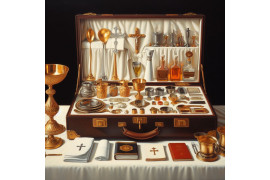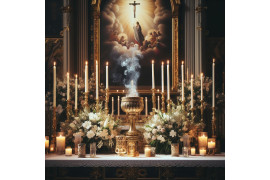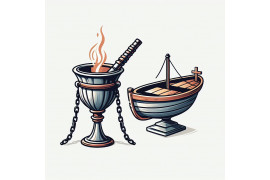Receiving Holy Communion is a sacred moment for many believers, and using a pyx adds an extra layer of reverence to this sacrament. To ensure the proper administration of Communion with a pyx, there are important guidelines to follow.
Firstly, it is crucial to prepare the pyx appropriately. Make sure it is clean and free from any contaminants before use. Handle the pyx with the utmost care and respect throughout the entire process.
Each religious institution may have specific instructions on how to administer Communion using a pyx. It's essential to familiarize yourself with these guidelines and adhere to them faithfully.
By following these steps, you can participate in this holy ritual with reverence and uphold the traditions of your faith.
Importance and Purpose of a Communion Pyx
A communion pyx plays a vital role in the Catholic faith, serving as a sacred vessel used to carry consecrated hosts for distribution to those unable to attend Mass. It allows individuals to receive Holy Communion outside the church setting, such as in hospitals or homes. Let's explore the significance and purpose of a communion pyx further.
Enables Distribution of Holy Communion
One of the primary purposes of a communion pyx is to facilitate the distribution of Holy Communion to individuals who are unable to physically attend Mass. This could include those who are sick, home bound, or residing in healthcare facilities. The pyx ensures that these individuals can still partake in the sacrament and receive the body of Christ.
Portable and Convenient
The use of a communion pyx makes it possible for priests or extraordinary ministers to bring Holy Communion directly to those in need. Its compact size and portable nature allow for easy transport, ensuring that the Eucharist remains secure throughout its journey from the church to its intended recipient. This convenience allows for greater accessibility and inclusivity within the Catholic community.
Safeguards the Eucharist
The communion pyx serves as a sacred vessel that safeguards the consecrated hosts until they can be received by the faithful. It is designed with reverence and care, constructed from materials such as gold, silver, or other precious metals. The interior is typically lined with white linen or silk, symbolizing purity and respect for Christ's body present in the Eucharist.
Symbolizes Reverence and Respect
By using a communion pyx during the distribution of Holy Communion outside of Mass, it emphasizes reverence and respect for this sacred sacrament. The act acknowledges that receiving Christ's body requires proper preparation and devotion regardless of where it takes place. The use of such a vessel underscores its importance within Catholic tradition.
Encourages Spiritual Connection
Receiving Holy Communion is a deeply spiritual experience for Catholics, representing the union between Christ and the faithful. The communion pyx allows individuals to maintain this connection even when they are unable to physically attend Mass. It provides comfort and solace, ensuring that those who are unable to leave their homes or healthcare facilities can still partake in this essential sacrament.
Communion Practices in Eastern Catholic and Orthodox Churches
In Eastern Catholic and Orthodox churches, the administration of Holy Communion is a sacred and significant moment for believers. Here, we will explore the unique practices surrounding communion in these traditions.
Spoon Administration
Unlike in other Christian denominations where communicants receive individual pieces of consecrated bread (known as hosts), in Eastern Catholic and Orthodox churches, priests administer Holy Communion using a spoon directly into the mouth of the communicant. This practice symbolizes the intimate connection between the believer and Christ during this sacramental act.
The Eucharist under Both Species
The Eucharist, also known as Holy Communion or the Divine Liturgy, is typically distributed under both species—bread soaked in wine—to represent Christ's body and blood. This practice aligns with biblical accounts of Jesus sharing bread and wine with his disciples at the Last Supper. By partaking in both elements, believers experience a fuller participation in the mystery of Christ's sacrifice.
Receiving While Standing
In Eastern Catholic and Orthodox churches, it is common for communicants to receive Holy Communion while standing. This practice reflects reverence and readiness to receive Christ's body and blood. Communicants often face an iconoclasts or altar during this sacred moment. The iconoclasts serve as a visual representation of heaven on earth, bridging the spiritual realm with earthly worship.
Sacred Rituals
The Divine Liturgy is rich with sacred rituals that accompany the distribution of Holy Communion. Before receiving communion, believers participate in confession to cleanse their souls from sin and prepare themselves spiritually for this holy encounter. Confession allows individuals to seek forgiveness for their transgressions before partaking in this sacred sacrament.
Reserved Sacrament
In accordance with canon law, any remaining consecrated bread from the Divine Liturgy is reserved for those unable to attend church due to illness or other reasons. This reserved sacrament, known as the "pyx," is carefully stored in a special container called a pyx and is taken by clergy to deliver Holy Communion to those who cannot physically be present during the liturgy.
The Role of Priests
Priests play a central role in the administration of Holy Communion. They undergo extensive training and are ordained to perform this sacred duty. During the consecration, priests invoke the power of the Holy Spirit to transform ordinary bread and wine into the body and blood of Christ. Their role is essential in ensuring that believers can partake in this profound spiritual experience.
In Eastern Catholic and Orthodox churches, communion practices are deeply rooted in tradition and symbolize believers' connection with Christ. Through spoon administration, receiving both elements, standing before an iconoclast, participating in sacred rituals, receiving from a reserved sacrament, and with the guidance of ordained priests, believers engage in a profound encounter with their faith.
Communion Practices in Present Day and Latter-Day Saints
In present-day Christian denominations, including Latter-Day Saints (Mormons), communion practices may vary significantly from traditional Christian practices. Each denomination has its own unique rituals and beliefs surrounding communion. Some denominations may not use a pyx at all, but instead distribute pre-packaged elements like bread and water cups during worship services.
Varying Communion Practices
Communion practices among different Christian denominations can differ greatly. While some churches follow traditional practices involving the use of a pyx, others have adopted alternative methods to distribute the blessed sacrament to their congregation. In the case of Latter-Day Saints, they have distinct beliefs and practices.
The Doctrine of Sacrament in Latter-Day Saints
Latter-Day Saints believe that partaking of the sacrament is an essential practice that helps them renew their covenants with God. They refer to this practice as the "Sacrament." During their worship services, which are called "Sacrament Meetings," members of the congregation gather to partake of bread and water as symbols of Christ's body and blood.
Distribution in Latter-Day Saint Services
In Latter-Day Saint services, the distribution of the sacrament is carefully organized. Typically, young men who hold the priesthood are assigned specific roles in preparing and distributing the bread and water to congregants. They do not use a pyx or any similar container for this purpose.
The process begins with individuals passing trays containing small pieces of broken bread to each row or pew within the congregation. Following this, another tray filled with small individual cups filled with water is passed around for each person to take one cup.
The Significance of Sacrament in LDS Beliefs
For members of The Church of Jesus Christ of Latter-Day Saints, partaking in the sacrament holds deep spiritual meaning. It serves as a time for reflection, repentance, and rededication to their faith. Through this practice, they seek to remember the sacrifice of Jesus Christ and renew their commitment to living according to His teachings.
Unique Practices in Latter-Day Saint Worship
Latter-Day Saints believe that during the sacrament, they can feel the presence of God and receive spiritual blessings. They view it as a sacred ordinance that connects them with their Savior and strengthens their bond with fellow believers. The practice of partaking in the sacrament is an integral part of Latter-Day Saint worship services.
Communion Practices in the Armenian Rite, Catholic Rite, and Eastern Rite for the Sick
In the Armenian Rite, priests bring consecrated hosts to sick individuals who are unable to attend Mass due to illness or other reasons. This ritual ensures that those who are unable to physically be present at church can still receive communion and participate in the sacrament. The priest visits the sick person's home or hospital room, carrying with them a pyx containing the consecrated hosts.
Armenian Rite:
-
The priest begins by offering prayers for healing and well-being.
-
The pyx used in this rite is typically made of silver and may be adorned with religious symbols.
-
Inside the pyx, a small white cloth is placed to hold the consecrated hosts.
-
The priest carefully places the consecrated hosts onto the cloth within the pyx.
-
After reciting prayers specific to this rite, the priest administers Holy Communion by placing a host on the tongue of the sick individual.
The use of a pyx in this context signifies reverence for the Eucharist and ensures that it is transported safely from the altar to those who cannot attend Mass. It allows for a personal connection between the priest and the sick individual during this sacred moment.
Catholic Rite:
In Catholicism, there are specific guidelines for administering Holy Communion to those who are ill or home bound using a pyx blessed by a priest. This practice is commonly referred to as "sick call" or "visitation of the sick."
-
A portable kit known as a "sick call set" or "pyx kit" contains all necessary vessels for administering communion outside of Mass.
-
The kit includes a pyx, which is usually made of gold-plated brass or another suitable material.
-
Within the pyx, consecrated hosts made from wheat flour are kept securely with a lid.
-
To administer Holy Communion, the priest or extraordinary minister of Holy Communion brings the pyx to the sick person's home or hospital room.
-
The sick individual receives communion by consuming a consecrated host placed on their tongue.
This practice allows for the sick individual to receive spiritual nourishment and participate in the sacrament even when unable to attend Mass. It emphasizes the importance of community and ensures that no one is left out from receiving communion.
Eastern Rite:
Eastern Rite churches have their own distinct practices for administering the Eucharist to the sick, often involving a pyx and prayers for healing. These practices vary among different Eastern Catholic Churches, but they share common elements.
-
The pyx used in Eastern Rite churches is typically made of precious metals such as gold or silver.
-
Similar to other rites, a small white cloth is placed inside the pyx to hold the consecrated hosts.
-
Prayers specific to healing and restoration are recited by the priest before administering Holy Communion.
-
The priest places a consecrated host onto the tongue of the sick individual, allowing them to partake in this sacred ritual.
These practices reflect the deep reverence and belief in the healing power of communion within Eastern Rite traditions. They provide comfort and spiritual support to those who are unwell or facing health challenges.
Contrasting Communion Traditions: Eastern and Western
In the realm of Christian traditions, the practice of receiving Holy Communion can vary significantly between the East and West. While both regions hold the Eucharist in high regard, there are distinct differences in their approaches and rituals.
Leavened vs Unleavened Bread
Eastern Christian traditions, such as those found in the Eastern Orthodox Church, typically use leavened bread during Holy Communion. This bread is made with yeast, resulting in a lighter texture. On the other hand, Western Christian traditions, like Catholicism, predominantly utilize unleavened bread for this sacred ritual. Unleavened bread is made without yeast and tends to be denser.
Mystical Nature vs Transubstantiation
The Eastern Orthodox Church places great emphasis on the mystical nature of the Eucharist. They believe that during communion, the bread and wine become truly transformed into the body and blood of Christ while retaining their outward appearance. This perspective is often referred to as "real presence."
In contrast, Western Christianity focuses on transubstantiation during Holy Communion. According to this belief held by Catholics and some Protestant denominations, the substance of bread and wine changes entirely into Christ's body and blood while still appearing as ordinary elements.
Varied Liturgical Practices
The liturgical practices surrounding Holy Communion differ between Eastern and Western Christian traditions. In Eastern Christianity, including Byzantine Rite churches, communion is typically administered using a spoon. The priest places a small piece of consecrated bread soaked in wine into each communicant's mouth from a chalice-like vessel called a "pyx." This method symbolizes unity among believers as they partake from one common cup.
In Western Christianity, particularly within Catholicism, communion is often distributed by placing a small unleavened host directly onto the communicant's tongue or in their hand. The host represents the body of Christ. In some cases, extraordinary ministers may assist in distributing communion to large congregations.
Eucharistic Adoration and Tabernacles
Eucharistic adoration, the practice of revering the consecrated host outside of Mass, is more prevalent in Western Christian traditions. Catholic churches often have a dedicated space called a "chapel" or "adoration chapel" where the consecrated hosts are kept in a special container known as the "tabernacle." This allows for private prayer and contemplation in the presence of Christ.
In Eastern Christianity, Eucharistic adoration is less common. Instead, the focus is on receiving communion during liturgical celebrations rather than separate devotional practices. The reserved sacramental bread is typically consumed shortly after its consecration and not stored in tabernacles for prolonged periods.
While these differences exist between Eastern and Western Christian traditions, both emphasize the significance of this sacred act. Whether through leavened or unleavened bread, mystical nature or transubstantiation beliefs, varied liturgical practices, or approaches to Eucharistic adoration, Christians around the world commemorate Christ's sacrifice through this holy sacrament.
Understanding the Process of Receiving Communion in a Pyx
We discussed the importance and purpose of a communion pyx, as well as various communion practices in different religious traditions. From the practices observed in Eastern Catholic and Orthodox Churches to those followed by Latter-Day Saints, Armenian Rite, Catholic Rite, and Eastern Rite for the Sick, we highlighted the diversity of communion traditions.
It is evident that the process of receiving communion in a pyx holds profound meaning for many believers across different faiths. Whether it is through the use of a pyx to bring communion to those who are unable to attend services or as part of specific rites within a religious tradition, this practice demonstrates reverence and care for spiritual nourishment. As you continue your exploration into this topic or consider incorporating the use of a pyx in your own faith practice, remember to delve deeper into specific rituals and customs within your particular religious community.
FAQs
Can I use any container as a pyx?
Yes, while traditionally made from precious metals like gold or silver, modern pyxes can be made from other materials such as brass or even wood. It is important to choose a container that is suitable for holding consecrated hosts and respects the sacred nature of the Eucharist.
How do I properly clean and care for a pyx?
To maintain its sanctity, it is recommended to clean a pyx with warm water and mild soap after each use. Ensure thorough drying before storage. Treat your pyx with reverence and respect when handling it outside liturgical settings.
Can anyone receive communion in a pyx?
The ability to receive communion in a pyx varies among different religious traditions and denominations. In some cases, only ordained ministers are allowed to carry consecrated hosts in a pyx. It is best to consult the appropriate religious authorities or clergy for guidance on this matter.
Are there any specific prayers associated with the use of a pyx?
Yes, in many traditions, there are prayers and blessings that accompany the use of a pyx. These prayers often invoke God's presence and ask for His grace to be bestowed upon those who will receive communion from the pyx. Consult your religious texts or seek guidance from clergy members for the appropriate prayers in your tradition.
Can I personalize my pyx?
While it is important to respect the sacred nature of a pyx, some individuals may choose to personalize their own pyxes within certain limits set by their religious tradition. This can include engravings, symbols, or personal dedications that hold significance for the individual using the pyx. However, it is crucial to ensure that any personalizations do not compromise the reverence and sanctity of the Eucharist or go against any guidelines provided by one's religious community.



